GES047 - West Park Asylum, Epsom
August 2009
West Park Asylum (or West Park Hospital) was a large psychiatric hospital in Epsom, Surrey. The hospital was designed by William C. Clifford-Smith (architect to the London County Council), who was also involved in the design of nearby St Ebba's Hospital. The hospital had been in planning since 1906, and by 1917 it was largely complete; however, the outbreak of war postponed opening until 1923.
When complete the hospital could cater for around 2,000 patients of mixed class. The hospital was slowly run down from the mid 1990s, and by 2003 most of the hospital was closed and derelict. A few outer ward buildings and villas remain open today and are still used for psychiatric treatment. History source: Wikipedia
The site seen from above in order to show scale. The main Admin house sits next to the circle lawn roundabout at the bottom of the pic, behind it the main hall still with it's roof on, before arsonists burnt it down. Main entrance is centre right edge. A crude overlay of the route taken is below.

On a warm August morning, I set off early to get to Morden station and meet TheSpaniard. Amazingly he was there on time smoking a roll up in the early dawn sun. We set off for Epsom, a 15min spin on the Vespa. We parked up in a side street near the main entrance, but not too near. The security guard seemed little bothered by us.
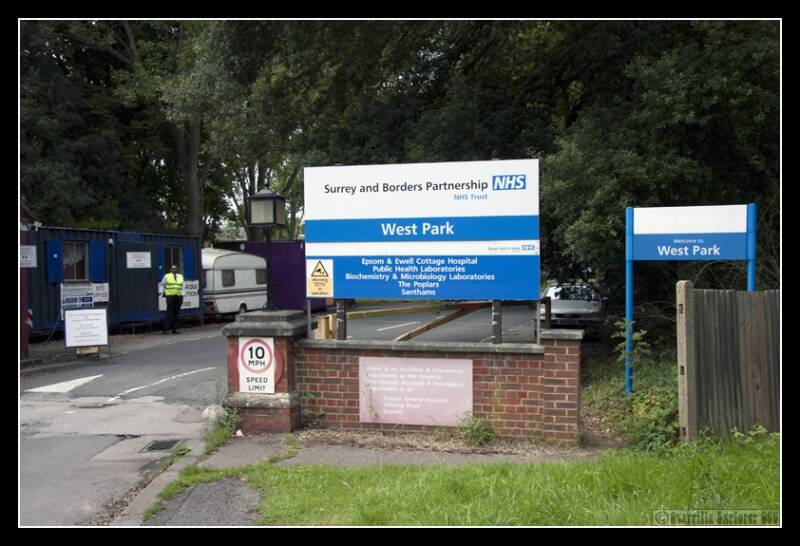
We walked down a wooded path on the side of the hospital, and then along the main road until we found a suitable fence to hop over. We came out near a Airing Court, where patients would take in the air.
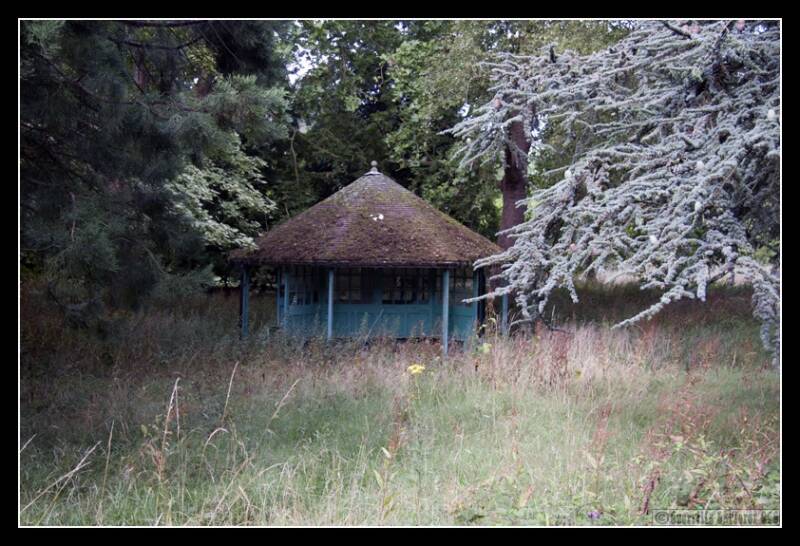
In front of us were the main buildings, we walked left keeping to the edge of the buildings, and snooping around each corner wary of security. I wasn't aware that the famous security guard MC Hammer had left, he was notorious for catching explorers in West Park. We came to a building with a precarious cracked window, that we could squeeze through. With some careful testing of the floor inside, we got through and stood inside what turned out to be Frinton Ward.
Finding the stairs we climbed to the first floor, where we were greeted by two large open rooms with a wooden partition in the middle. In the room we had entered, there was a wheelchair sat in the middle of the room and a thin film of green slimy water. Through the wooden partition, we came into a longer room, with various bits and bobs lying about. Someone had exploded some foam padding near the rooms exit door. The ceiling had peeling paint all over it, as did the walls. The floor was also wet with the green slimey water. TheSpaniard takes some pics.
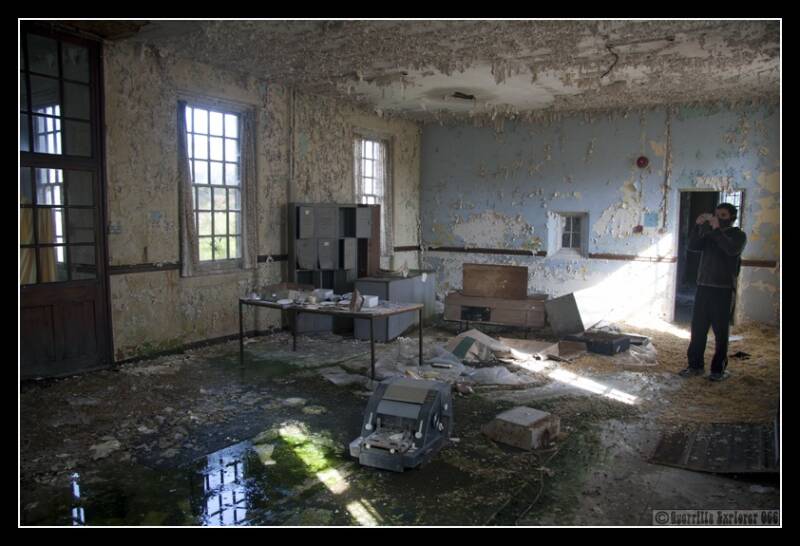
A close up of the iron on the table.
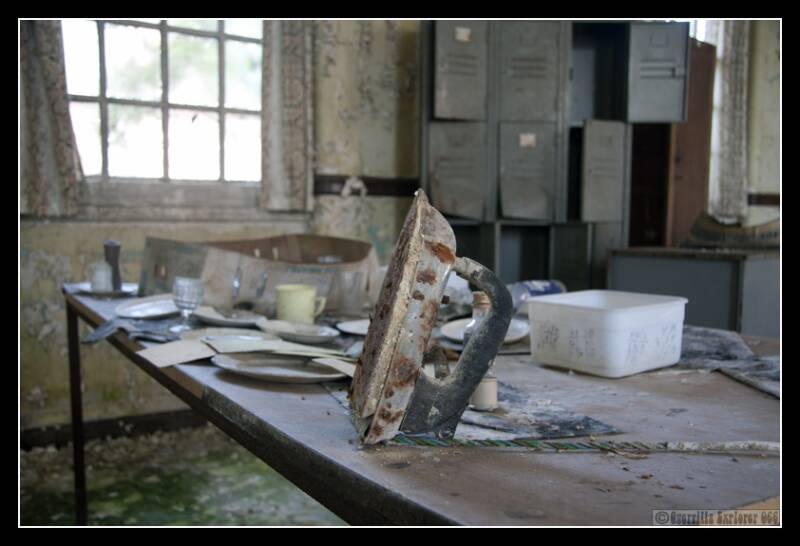
Back downstairs TheSpaniard sparks up a dutch cheroot while I explore through a large hole in the floor the basement. It lead to a corridor with lots of arches and empty side rooms/caverns. The basement ended with a thin corridor squeezing off behind some pipes. With knowledge that asbestos is present here, we opted to not go any further. On the way back we did some lightpainting experiments.
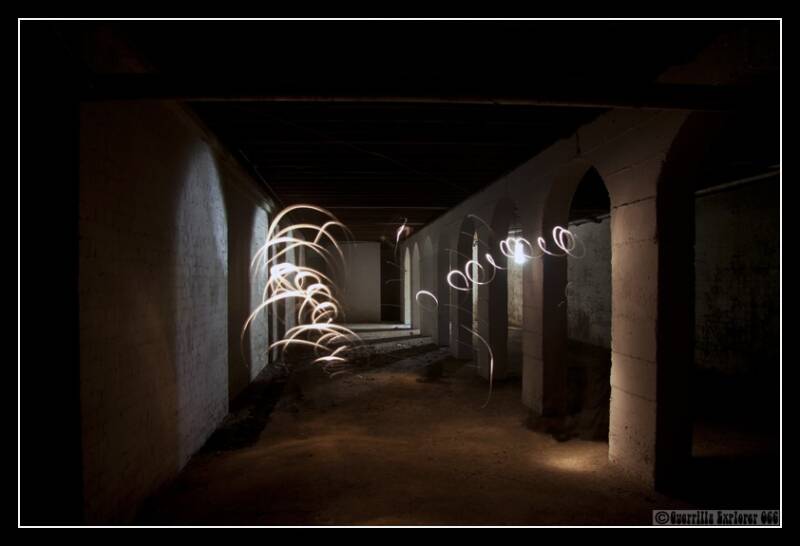
We climbed back up and looked around the side of the ground floor we hadn't explored. A room had some old lampshade globes that looked rather cool.

We found our way out into the myriad of corridors that hem in various areas of the internal section of West Park. We couldn't seem to find a way into the corridor section, so I opted to climb onto the roof of the corridor and try to get in at a high level to a building. However there was nothing obvious to see. So I kept on going along the roof, hiding behind trees and flipping from one side to the other to avoid potentially being spotted. I reached a low single building, built later than the other buildings. I found a low part of the roof and waited for TheSpaniard to follow behind me.
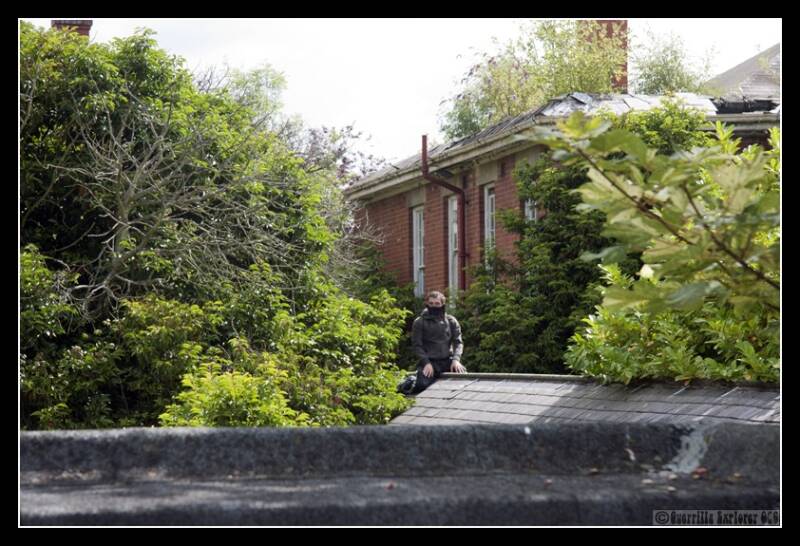
We were on the roof of the Patients Social Centre. We dropped down to get in through a huge open window that had been smashed in. And found ourselves next to a trolley with some VHS tapes on it. Ahead of us a mountain of chairs piled up. We turned left, and ended up in a hair salon. A row of hair driers in a glass lined room sucking in the morning light.
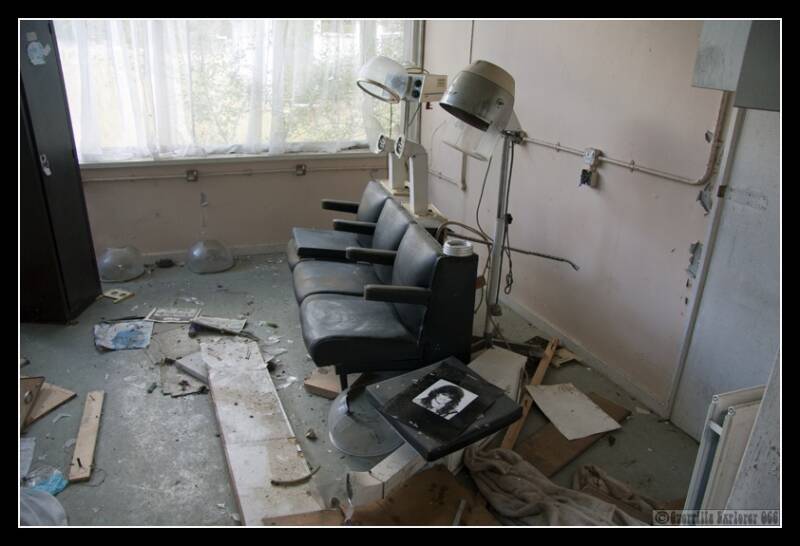
Back out into the entrance, and we walked into the main hall where small scale events would have been put on. streams of small fairy lights ran across the ceiling.
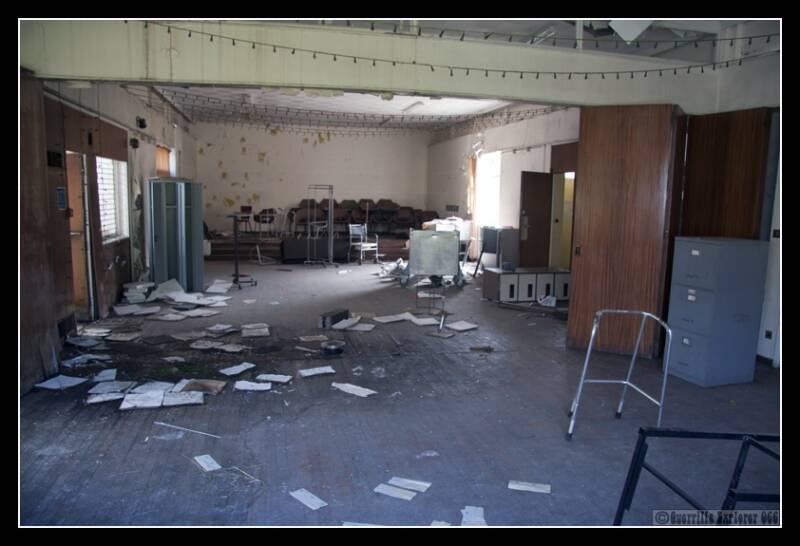
Zimmer frames were plentiful, as was the result of mindless ransacking. We stopped to watch the 'Three Zimmers' do their concert, and carried on.
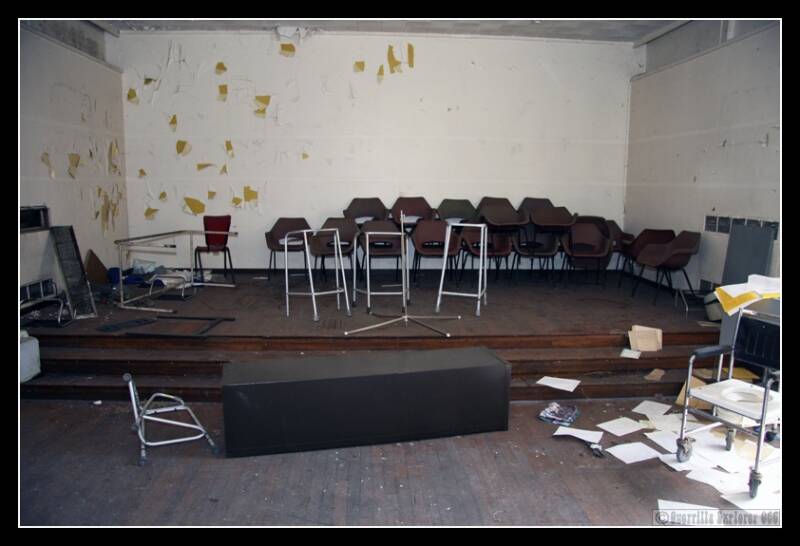
We climbed back out of the window we'd entered, and next to it was another smashed window which some kind person had put a chair next to. It seemed wrong not to use their route to avoid the boarded up doors that locked the Social Centre from the corridor system. In through the window, and we were finally in the corridor system, and walked cautiously on. The first ward block we came to was Granton/Guildford Wards.
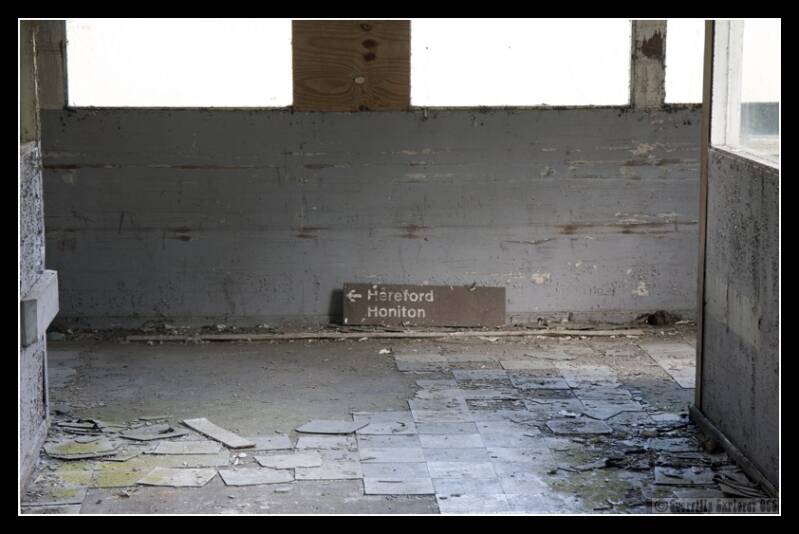
Most buildings either contained 2 wards as 'L' shaped wards joined together, or as blocks of 4 'L' shaped wards joined up as a horizontal bar. The longer bit of the 'L' being the wards, the shorter bit being admin, toilets and showers/baths.
We entered through the door of Granton/Guildford Wards, which was nice. Hitting the stairs for a wander around. There was the sad site of numerous suitcases everywhere, never reclaimed/returned by/to their owners.

As we ventured further into the first floor wards, it became clear the arsonists had been having fun here. The walls were soaked in charred paint, and on the ceilings patterns had formed where flames had licked across. Like Frinton Ward, water lay like a lake on the floor, dark and dirty. It did produce some nice reflections for the lens though.
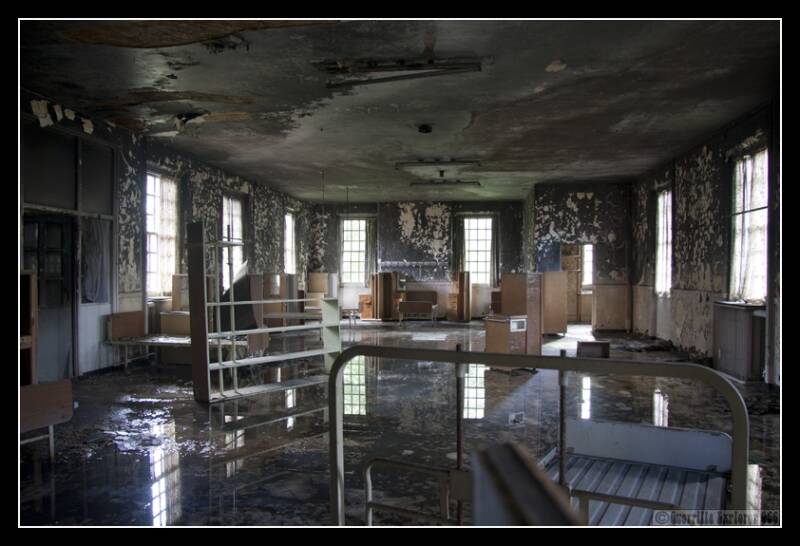
Around the corner the toilet and shower block had fire damage as well, the ceiling paint hung like grimy stalactites. A wheeless bicycle had also been dumped here.

On a wall the paint had been affected by the flames of the fire, and one could see what looked like screaming faces in the melted paint. Similarly hanuting akin to Munch's Scream.
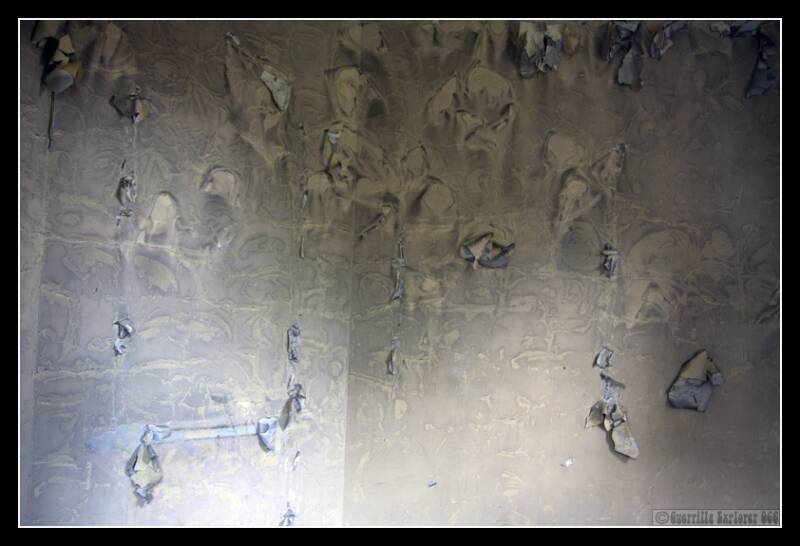
We went back downstairs, and prepared to walk to the next building where we could see the door's clearly open. Just as we were about to leave, we heard voices close by and hid behind a door in a room. The room had lots of crockery in it still nearly piled up on shelves.
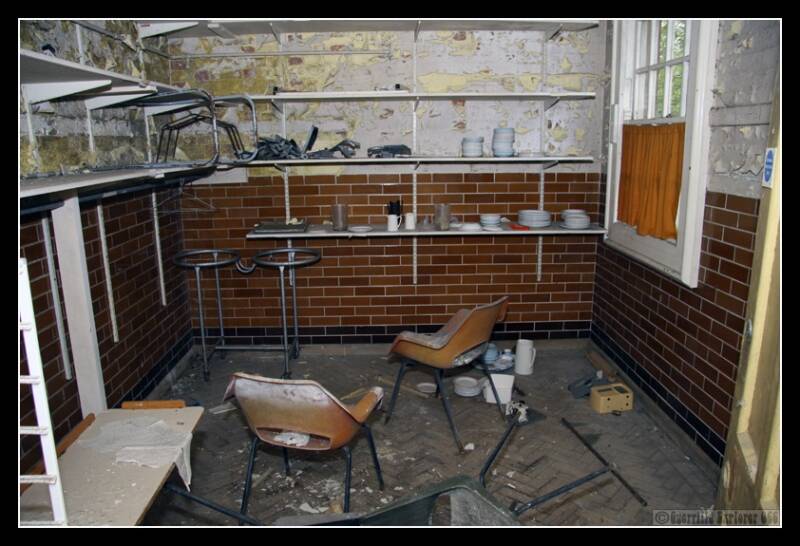
The voices went, and with the all clear, we crossed to the next building. It wasn't until we exited through the main door that I realised the name of the ward, Hereford/Honiton. I had grown up in Hereford, where Burghill Asylum had entertained as a teenager.

The ground floor's floor was well dodgy, with clear open holes in places, and a distinct wobbliness in others. On the other half of the building, it had a solid floor with green dividing curtains hanging forlornly casting shadows on the crumbling surfaced floors.

Around the corner were more clearly defined cubicles sans beds. The peeling paint hanging down like cheap Christmas decorations.
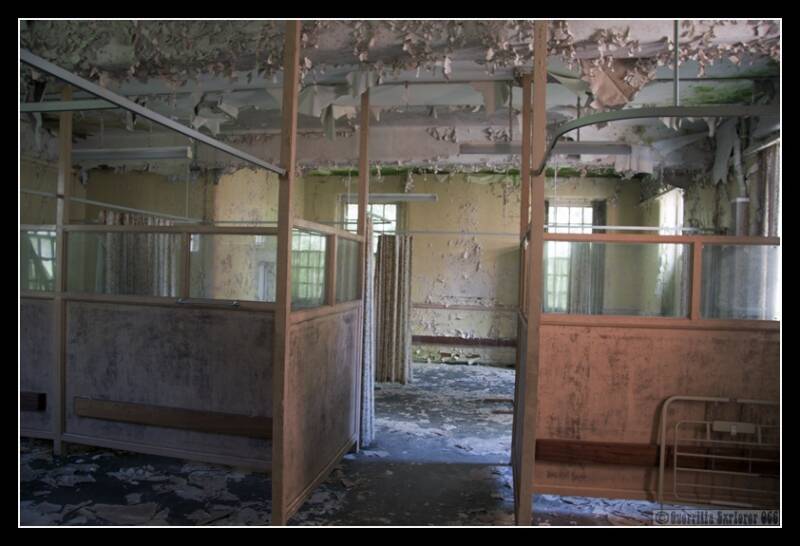
As we went upstairs it was a bit of a shock, for there was no roof! It had been burnt in another fire started by the arsonists. However it had left a magical land of greenery growing amongst the derelict remains of the building. Twisted orange rusting iron introducing contrasting colour to the sprouting verdure.
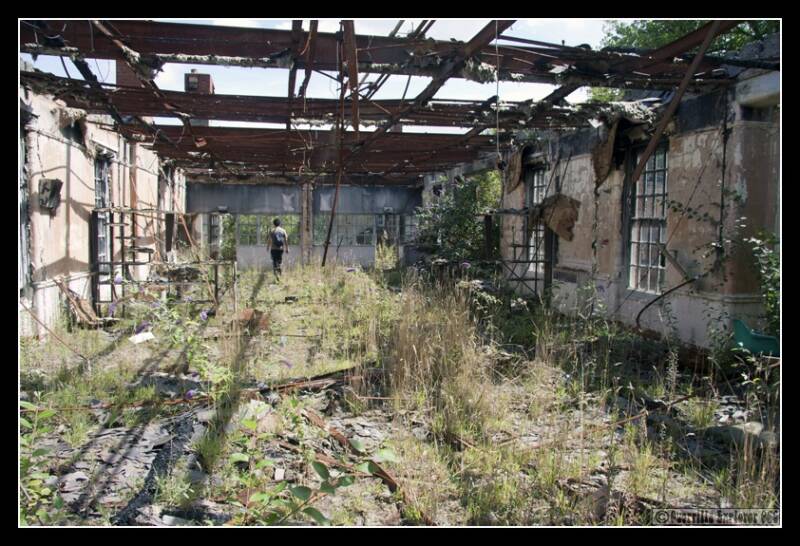
I liked this ward a lot, and over coming visits would always come back for a look at my favourite part of West Park Asylum. Pretty much everything within this ward is photogenic.
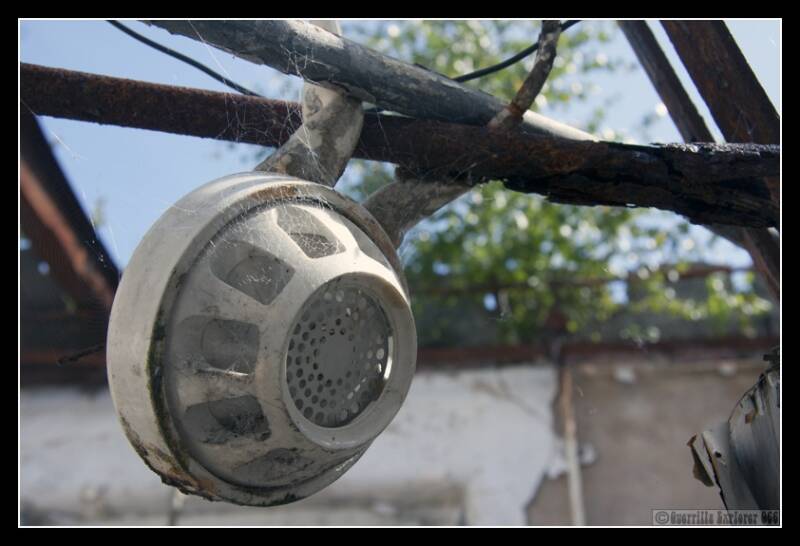
We got back into the corridor system, and headed deeper into the Hospital. Still unaware of the fact that security weren't active in this period, we carefully darted from room to room. Small empty offices of little significance provided hidey holes as we progressed.
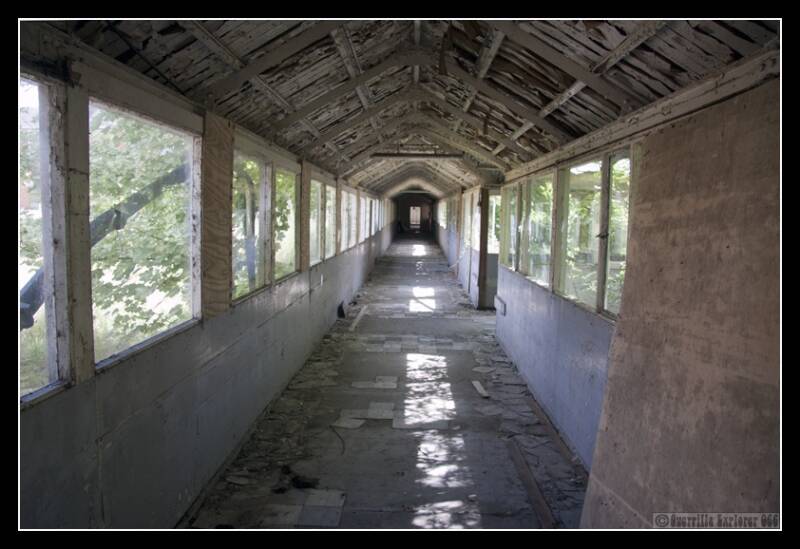
And the end of this corridor, we turned right into Lister House. It was made up of small office rooms lacking anything of interest. As we came back out into the corridor, we were faced with a breeze block wall built to stop people progressing. Luckily someone had left a handy chair next to it, and we climbed over. We ended up in the huge Kitchen area. Some ovens still remained, but most equipment had been removed.
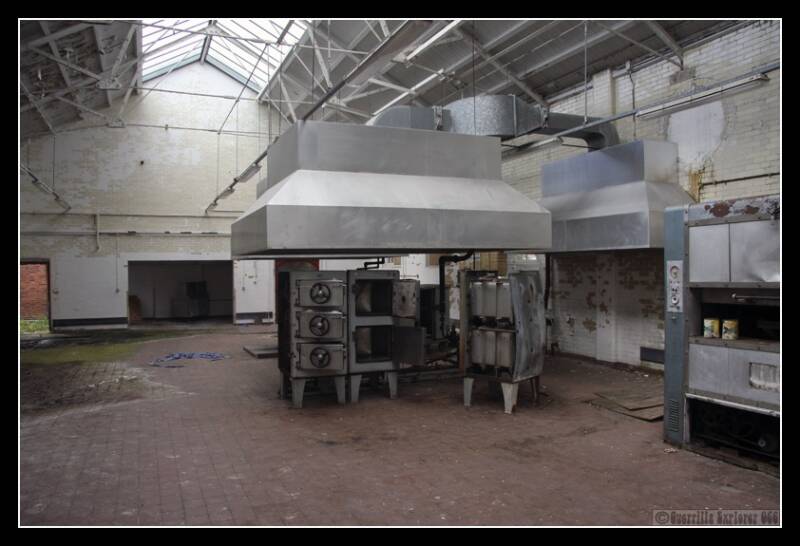
We passed through a cavernous dining area with curved roof, and into the main hall. Where once had been a great hall, now the metal roof supports were the only reminder of what was. The floor had been completely removed to take away asbestos remains, now exposed due to the fire that had swallowed the roof. At the far end was a stage for entertaining patients and visitors.
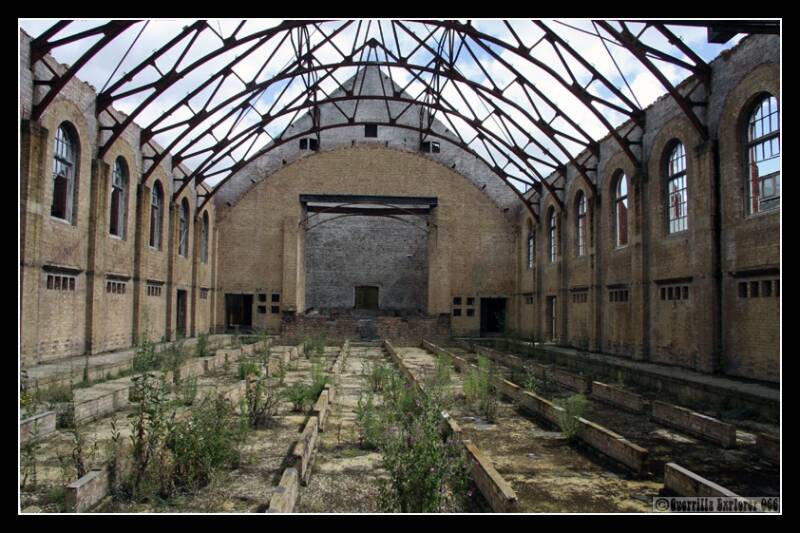
A shot taken from the back of the stage area. At the rear of the hall, you can see two doorways. Above the one on the left, is a collection of four oddly placed holes in the brickwork, not matched on the other side. This is where the projection room sits. The projector showing films through the long thin hole to a screen somewhere in the hall. The smaller holes just above allowed the projectionist to check on proceedings.

We then went into the corridor near the kitchens and crossed into Bond House, which wasn't particularly exciting. Mostly small rooms that were once offices, and now lay stripped and bare. I looked across at the charred remains of Hereford/Honiton wards.
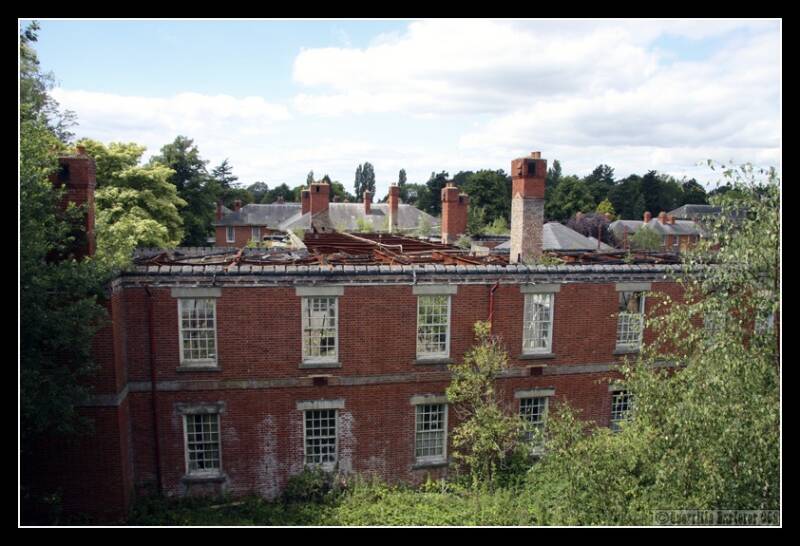
From here we walked back down a long corridor which was going back in the direction we'd entered the site. The first side corridor we came led into a 4 ward block, we wandered into Burford Ward. This had the wibbly wobbly floor we were becoming used too. It also had some nice wooden ward partitions with glass providing continuous light. The peely paint stalactites were in larger clumps here.
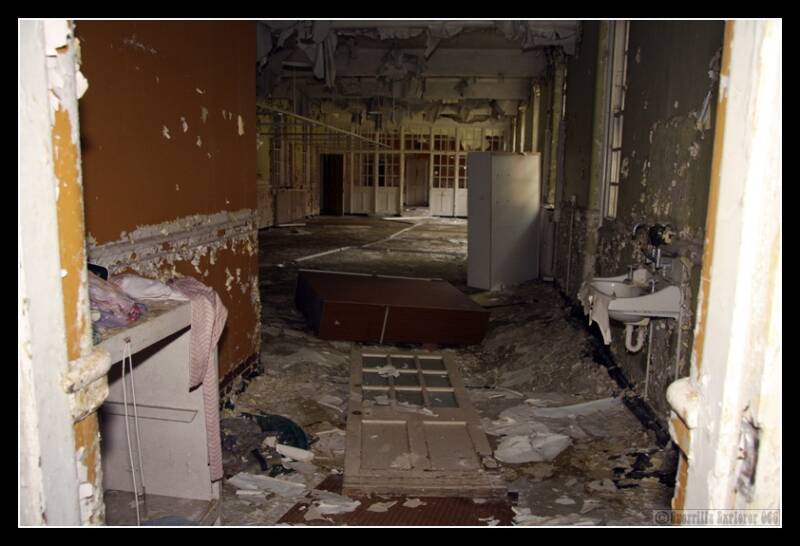
We heard noises coming from upstairs, and a distinct smell of aerosol was in the air. We had no idea what was going on. As we climbed the stairs using ninja stealth, we found a side room off the stairs with patients belongings in.
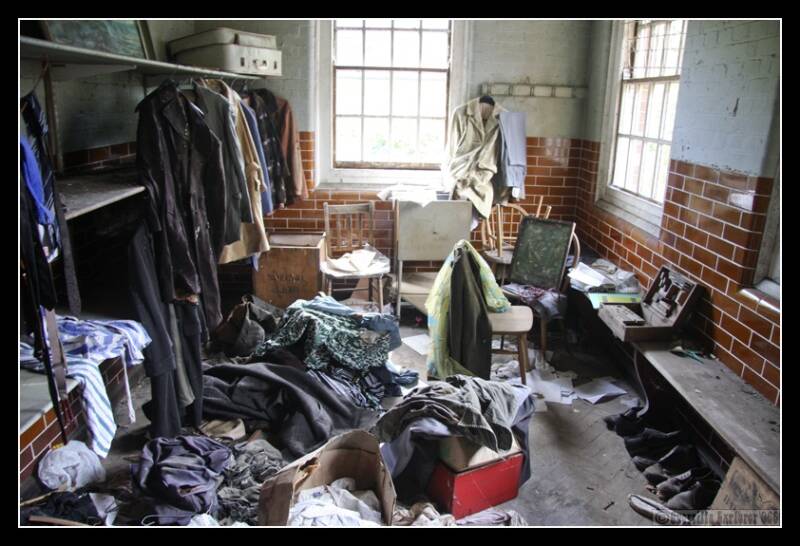
I continued up the stairs, and crept around the corner to see what was going on. It appeared some graffiti artists were spraying a wall, and another guy was videoing it. A woman probably a girlfriend, lay on the floor watching. I signalled to TheSpaniard that it was safe, and he came into the room. Both of us love good graffiti, so were keen to admire the artists work.

I got chatting to the guy documenting it, Jeremy, and he told us that the famous padded cell was just around the corner. We went off to Barton ward, through the doorway beside the graffiti in the photo above, then turned down a narrow corridor with lots of doors on one side. One of the doors was ajar, and inside the padded cell. Sadly someone had chosen to remove the padded door. This was the only in-situ padded cell in the country. It was weird to be in it, and wonder what it would have been like for the person confined to it. It had actually been used for storage for many decades before the wards closed. It was actually used for epileptics so they wouldn't hurt themselves, rather than the popular image of loonies in straightjackets.

We took some photos of each other in the cell, and headed back to the graffiti artists. Behind them was Abington Ward, and some rather different graffiti!
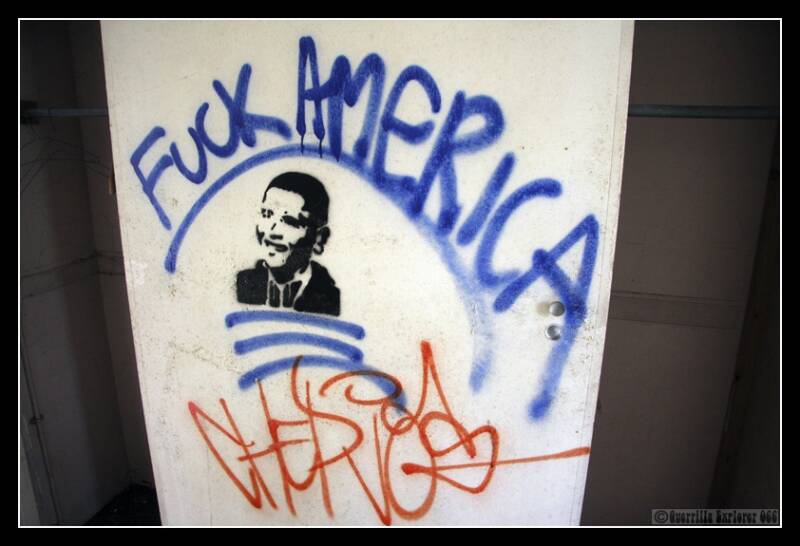
Further on was some even worse graffiti by bored teenagers most likely, looking to be dangerous by using facist insignia. A shame, as the glazed brickwork was gorgeous.
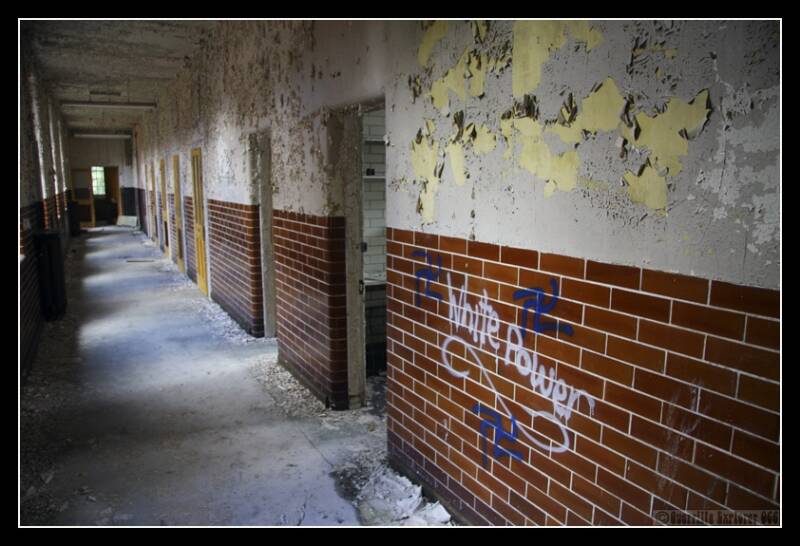
We left the graffiti artists in search of one more thing I wanted to see at West Park. Research told me it was in the Admin building. So back to the Main Hall, we found a long dark corridor that lead up to the Admin building. A wood lined staircase curled up to the first floor. In one of the rooms I found what I was looking for, the so called 'hoover room'.
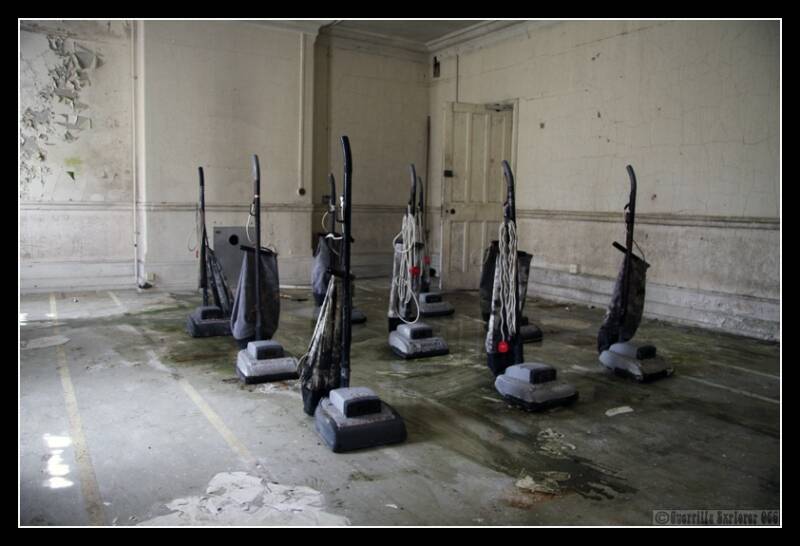
I liked what people had done, and it inspired me to do similar things on subsequent trips. Most well known is my collecting of fire extinguishers to form a pentagram, which became a swastika, which became a love heart etc etc.
It was lunch time now, around 2am, so we decided to call it quits, and left the site the way we'd entered. We went down the hill to the rather splendid looking ye olde pub on the Stamford Green for a pint and pack of crisps. It was a great explore we both thoroughly enjoyed, and were only too keen to come back.
Add comment
Comments